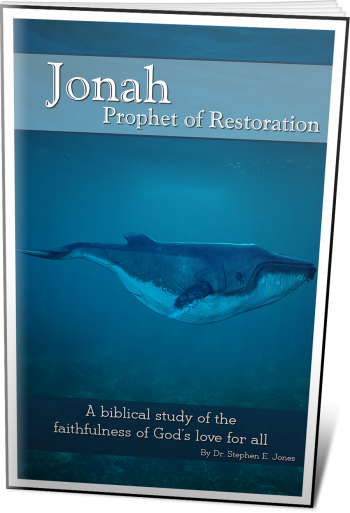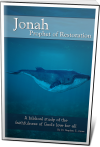Latest Posts
View the latest posts in an easy-to-read list format, with filtering options.

Jonah is the Prophet of Restoration. He is the prophetic witness of the law of cleansing lepers (Lev. 14) and the law of the Day of Atonement (Leviticus 16). He is a prophet who proves that God is concerned about non-Israelites, and questions Israelite nationalism and exclusivism. The book of Jonah is one of the most remarkable books in the Bible.
Category - Bible Commentaries

Jonah 1:3 says,
3 But Jonah rose up to flee to Tarshish from the presence of the Lord. So he went down to Joppa, found a ship which was going to Tarshish, paid the fare, and went down into it to go with them to Tarshish from the presence of the Lord.
From his home town in Zebulun in the north part of Israel, Jonah went “down” (south) to Joppa, a city along the coast. Notice first how many times Jonah went “down.” After going “down” to Joppa, he “went down” into the boat. When the storm arose, “Jonah had gone below into the hold of the ship, lain down, and fallen sound asleep” (Jonah 1:5).
From there, he was cast overboard, where he went down, first into the water, and then into the belly of the fish, at which time he “descended to the roots of the mountains” (Jonah 2:6). Fleeing from the presence of the Lord carries people in just one direction—down.
In Hebrew thought, going “up” to Jerusalem or “down” to the land of the Philistines was a well-known metaphor. Jerusalem was situated on a mountaintop, and so going up to Jerusalem signified rising to a higher level of glory in the knowledge of God. If one descended far enough, he would find himself among the nations that did not have the knowledge of God that Israel enjoyed.
So Jonah went down, down, down, until he reached the depths of the abyss, far away from the glory of God’s presence in Jerusalem.
Jonah 1:4, 5 says,
4 And the Lord hurled a great wind [ruach, “spirit, breath, or wind”] on the sea, and there was a great storm on the sea so that the ship was about to break up. 5 Then the sailors became afraid, and every man cried to his god, and they threw the cargo which was in the ship into the sea to lighten it for them. But Jonah had gone below into the hold of the ship, lain down, and fallen sound asleep.
The Hebrew word ruach carries a double meaning of wind and spirit. For this reason, the great wind, or tempest, is seen to be the breath of God blowing across the waters. It is a statement of the sovereignty of God, so that we know that such tribulation is directly or indirectly all of God. There is no doubt that God Himself brought about this storm in order to fulfill His purposes.
We see a similar story in the New Testament, when the wind of God blew upon the Sea of Galilee. In fact, the story in Matt. 14:22-34 is meant to be connected to the story of Jonah. Peter left the boat to walk on the water toward Jesus. Simon—soon to be called “Peter”—was the “son of Jonah,” for we read two chapters later in Matt. 16:17, “Blessed are you, Simon Bar-jona,” or Son of Jonah.
Both Jonah and Simon Bar-jonah left the boat. Jonah was cast out at his own request, while Simon Peter stepped out of the boat without assistance. Both were acts of faith, because both men knew the will of God and acted upon it.
The story of Simon Peter is told in John 6 as well as in Matthew 14. We read that it took place the night after Jesus multiplied the bread to feed the five thousand. According to John 6:4, this occurred around the time of Passover—technically, at the wave-sheaf offering shortly after Passover, since it was barley bread that was multiplied. The incident was to illustrate the purpose of Christ’s death on the cross, where His body was “broken” to feed the world.
The people then wanted to crown Him king (John 6:15), so He withdrew Himself to a high mountain to pray (Matt. 14:23). This foreshadowed Christ’s ascension to heaven, where “He always lives to make intercession for them” (Heb. 7:25).
Before going to the mountain to pray, however, Jesus compelled the disciples to get into the boat and sail to the other side of the lake (Matt. 14:22). This prophesies of the church being sent into the nations (stormy seas, or tribulation) to preach the word, while He remains in heaven making intercession for them.
Later, at some point in time, Jesus came to them, walking on the water, and Peter went out to meet Him. This prophesied of the second coming of Christ.
The main difference between the two stories is that when Jonah was cast overboard, he was a type of Christ in His first coming, because He had to be swallowed up by the whale and thus enter “the heart of the earth” (Matt. 12:40). By contrast, in John 6, Christ’s first coming is covered by the story of the breaking of the bread, for this prophesied of Christ’s body being broken in order to feed the multitude. Peter’s experience in walking on water prophesied of the second coming of Christ, because he went out to meet Christ after He had finished His time of intercession on the mountain (1 Thess. 4:17). The second coming of Christ is a living work, not a death work.
Peter plays a dual prophetic role, because at the time of Christ’s second coming, there are two groups of overcomers who will receive immortality at that time. First there will be the dead overcomers who are raised from the dead on the Feast of Trumpets. Then, two weeks later on the first day of the feast of Tabernacles, those overcomers who are alive when Christ returns will be “changed” (1 Cor. 15:51).
Peter unites both groups in a single character. He represents the first group by sinking into the water and by being raised up by Jesus. He represents the second group in a broader fashion simply because he was alive when he stepped out of the boat.
Peter distinguishes himself from the other disciples in this prophetic story. The eleven disciples can be viewed as the church in general, while Peter is the overcomer. Peter goes out to meet Jesus, while the rest of the disciples (church) remain in the boat.
This story teaches us that the overcomers alone are qualified to go out to meet Christ at His coming. Hence, not all believers will receive immortality at Christ’s coming. Most will have to wait until the Great White Throne judgment, where they will be among the righteous ones, as Jesus mentioned in John 5:28, 29. For a longer study of the two resurrections and the Jubilee at the end of time, see my book, The Purpose of Resurrection.
In both stories (Jonah and Peter), the wind stirring the water was the breath of God. This is easy to see in the story of Jonah, because we are told in Jonah 1:4 that “the Lord hurled a great wind on the sea.” We find no specific statement telling us this in the story of the disciples on the lake. But when we look at the prophetic context, it is clear that God intended for the church to go into the “tribulation” of the storm. Jesus “constrained His disciples to get into a ship” (Matt. 14:22, KJV).
The connecting link between Jonah and Simon Peter, as I said earlier, was the fact that Peter was the Son of Jonah. But there is yet another link, given in Mark’s account of the story. We read in Mark 6:45,
45 And immediately He made the disciples get into the boat and go ahead of Him to the other side to Bethsaida, while He Himself was sending the multitude away.
The disciples were sent to Bethsaida, but they actually ended up at Capernaum. Why?
Neither Matthew nor John mention that Jesus had sent them to Bethsaida. Only Mark tells us this detail. Matt. 14:32 says only that after Jesus was escorted by Peter back to the boat, “the wind stopped.” Matthew does not tell us where the boat was heading, nor where it landed.
John gives other details. John 6:17 says, “after getting into a boat, they started to cross the sea to Capernaum.” The crowd then found Jesus and the disciples in Capernaum (John 6:24). We do not doubt this, of course, but Mark says that their original destination was Bethsaida. Why did Jesus then take them to Capernaum?
Well, they had to be sent at first to Bethsaida, “house of fish,” in order to fulfill the type of Jonah being sent to Nineveh, the “City of Fish.” But they landed in Capernaum, because the name of that town in Hebrew is Kaphar Nahum, or “Covering of the Comforter.” John’s message was to connect that city with the outpouring of the Holy Spirit, the “Comforter,” and with Nineveh upon which the Holy Spirit came when the entire city was converted.
Jonah was heading for Tarshish and ended up at Nineveh, “Fish City.” Jesus’ disciples were heading for Bethsaida, “House of Fish,” and ended up at Capernaum. Bethsaida is Nineveh, but landing at Capernaum is the equivalent of the city of Nineveh being converted and filled with the Spirit of God. It is as if Nineveh’s repentance turns it from Bethsaida to Capernaum.
So we read in Jonah 4:11 that Nineveh had a population of 120,000. That number (120) is associated with the outpouring of the Holy Spirit and the glory of God (1000). When the glory of God filled Solomon’s temple, there were 120 priests blowing trumpets in one accord (2 Chron. 5:12). There were 120 disciples in the upper room when the Holy Spirit was poured out at Pentecost (Acts 1:15; 2:1-3).
By comparing these two stories, we see that the second work of Christ is designed, not to destroy the world, but to save it by the preaching of the word and the power of the Spirit. There will be a great outpouring of the Holy Spirit that will not destroy the world (“Nineveh”), but save it. There will be a great repentance as the glory of God is seen throughout the whole earth.
As we will see, this is, in fact, the main lesson in the story of Jonah. The reluctant prophet preferred judgment to be poured out upon Israel’s enemies. He disagreed with the divine plan, and this is what put him at cross purposes with God. In this way, Jonah is a type of the church, which, as a whole, prefers to see divine judgment upon the world. In that sense, the church is still running from God even to this day, for they are following the pattern prophesied in the story of Jonah.
Whereas the wind of God brought death to Jonah, the same wind also brought Jonah back to life and then brought the Holy Spirit to Nineveh—the world of God’s enemies.